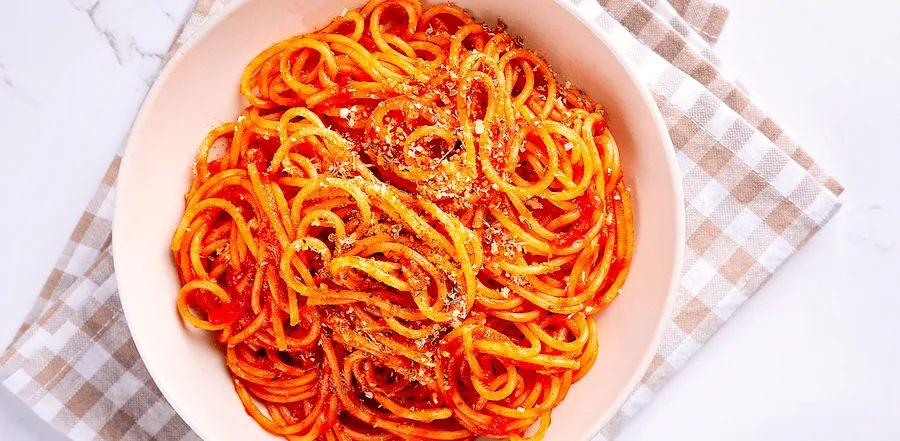The Key to Getting Pasta Sauce to Stick to Your Noodles

Dining on pasta at a restaurant feels like a treat. The noodles have just the right bite, while the sauce is rich, glossy, and often creamy — all without the need for dairy — and it clings to the pasta as if it were part of the noodle itself, making each bite feel perfectly balanced.
At home, however, the experience can be disappointing. As you twirl your spaghetti, the watery sauce slides off, leaving you with a plate of mostly plain noodles and a puddle of sauce that refuses to stay put.
You might think that restaurants have the upper hand because they use homemade sauces that have been slow-cooked for hours, paired with fresh pasta made just before your arrival. While premium ingredients certainly help, the real trick behind the perfect pasta-sauce marriage is a technique called emulsifying — a trick you can easily use at home to elevate store-bought pasta and jarred sauce.
An emulsion is a simple concept: two liquids that usually won’t blend are forced to mix together. In the food world, you’ve likely seen this in the difference between oil and vinegar that separate in a salad dressing, and the smooth, creamy vinaigrette that stays combined. That smooth dressing is an emulsion, where oil and vinegar are united despite their natural tendency to repel each other.
There are three crucial steps to properly emulsify any pasta sauce: saving some pasta water, adding fat gradually, and incorporating plenty of movement — which, in this case, means stirring, mixing, or flipping the pasta. (Though, if you're frustrated, cooking can be a great way to work that out too.)
The Art of Emulsifying Pasta Sauce

LauriPatterson/Getty Images
To break it down further, here’s how the process would unfold for a single serving of boxed spaghetti and jarred marinara sauce.
Step 1: First things first, make sure you have some butter chilling in the fridge — and leave it there. (For a non-dairy option, cold Earth Balance works just as well.)
Step 2: Next, bring a pot of heavily salted water to a rolling boil, using a two-quart pot.
Step 3: Add 3 ounces of spaghetti (this is roughly the diameter of a quarter if you’re measuring by hand). Cook just until it’s slightly underdone. You’ll know it’s at the right point if you take a bite and see a tiny white spot in the center where the pasta isn’t fully cooked yet.
The reasoning behind this: the pasta will continue cooking once it’s added to the sauce. If you pull it out fully cooked, it will likely end up overcooked by the time you’re done mixing everything together.
Step 4: Before draining the pasta, reserve at least half a cup of the cooking water. This starchy water acts like glue, helping to bring the sauce together. You might not know if you’ll need it yet, but once it’s down the drain, you can’t get it back — so better to save it now and thank yourself later.
Step 5: In the empty pot you used to cook the pasta, pour in about half a cup of your favorite tomato sauce. This will be just enough to coat the pasta without drowning it. Bring the sauce to a gentle simmer, allowing the bubbles to start agitating everything, setting the stage for the next steps.
Step 6: Remember that cold butter in the fridge? It's time for it to work its magic. Take it out and drop in half a tablespoon of butter, stirring constantly. As the cold butter melts into the simmering sauce, keep adding more, half a tablespoon at a time, until the sauce thickens enough that when you drag a spoon through it, you can see the bottom of the pot without the sauce quickly filling in the gap.
The amount of butter you’ll need depends on how thick or watery your jarred sauce is, but don’t exceed 2 tablespoons. You’ll know it’s right when the sauce is dotted with tiny, shiny beads of fat evenly distributed throughout. It shouldn't look like a pool of melted butter sitting on top of the sauce.
Step 7: Once the sauce has reached the right consistency, add the drained pasta back into the pan and stir vigorously. This motion helps emulsify the sauce further, thickening it by incorporating starch from the pasta. Mixing pasta and sauce in the pan, instead of just pouring sauce over pasta on a plate, is the key to achieving that restaurant-quality finish.
Different pasta shapes absorb sauce in unique ways, so use your judgment to determine if the sauce has the right consistency. If it seems too thick, add a little bit of the reserved pasta water, drop by drop. If the sauce becomes too thin, just let some of the liquid cook off, and it will thicken back up. The sauce is pretty forgiving at this point.
Learn More About Emulsification
Ultimately, it’s the gradual blending of fat, starch, and acid (in this case, from the tomatoes) that creates a unified dish, where separate ingredients that would never mix together quickly now form a cohesive sauce. This fundamental technique can be applied to any sauce.

Claudio Caridi/Getty Images
If you’re excited to try this with a homemade sauce, start with a simple aglio e olio (garlic and oil). Gently heat garlic slices in olive oil, along with any other aromatics you like, such as freshly cracked black pepper or spicy red pepper flakes. Once the garlic is fragrant, mix in the cooked pasta and gradually add some reserved pasta water, stirring vigorously. As you mix, you’ll see the sauce come together and thicken.
To really elevate your dish, even with jarred sauce, remove the pasta and sauce from the heat and gradually stir in teaspoons of grated Parmesan, followed by a splash of pasta water. Keep stirring vigorously to melt and integrate the cheese. This technique, combining Parmesan and pasta water slowly, is the secret behind the famous cacio e pepe — the ultimate emulsified sauce — and now you’re ready to try making it yourself.

1

2

3

4

5
Evaluation :
5/5